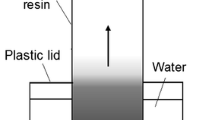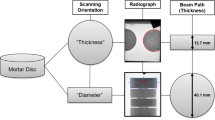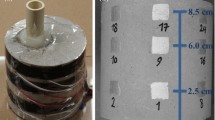Abstract
The movement of water or water carrying aggressive ions is one of the leading causes of deterioration of concrete structures worldwide. Moisture profiles during unsteady state wicking were determined by one dimensional magnetic resonance imaging of 10 cm mortar specimens. Bulk free induction decay and T *2 lifetime mapping results show a bi-exponential behavior of the MR signal lifetime, T *2 , in all samples, indicating at least two different water populations. From T *2 mapping, the short T *2 lifetime, assigned to interlayer water (water between C–S–H layers), and its associated amplitude are constant along the sample. The long T *2 lifetime and its associated amplitude, related to water in the pore space (micro and macropores), change with local moisture content. To the best of our knowledge, this is the first time that interlayer water has been spatially resolved in MRI of cement-based materials. Gravimetric sorptivity measurements show two regimes of water absorption in the four samples studied. In the first regime, a capillary transport mechanism is dominant in filling the macropores. In the second regime, the interaction between water and solid matrix is postulated to cause swelling that results in a reduction of the water absorption rate. After swelling, diffusion controls pore filling. Water front penetration behavior observed with magnetic resonance imaging, and bulk free induction decay measurements showed changes in behavior that can be linked to sorptivity changes from an initial to a secondary regime. Inverse modelling was conducted to extract the transport properties, using the Hydrus program with the one-dimensional moisture content profiles. Modelling results showed a decrease in saturated hydraulic conductivity with water exposure time.









Similar content being viewed by others
References
Neville AM (1995) Properties of concrete, 4th edn. Longman Group Limited, Harlow Essex
Hall C (1989) Water sorptivity of mortars and concretes: a review. Mag Concr Res 41:51–61. https://doi.org/10.1680/macr.1989.41.147.51
Sarja A (2000) Durability design of concrete structures-Committee report 130-CSL. Mater Struct 33:14–20. https://doi.org/10.1007/BF02481691
Martys NS, Ferraris CF (1997) Capillary transport in mortars and concrete. Cem Concr Res 27:747–760. https://doi.org/10.1016/S0008-8846(97)00052-5
Aldred JM, Rangan BV, Buenfeld NR (2004) Effect of initial moisture content on wick action through concrete. Cem Concr Res 34:907–912. https://doi.org/10.1016/S0008-8846(03)00202-3
Puyate YT, Lawrence CJ, Buenfeld NR, McLoughlin IM (1998) Chloride transport models for wick action in concrete at large Peclet number. Phys Fluids 10:566. https://doi.org/10.1063/1.869584
Puyate YT, Lawrence CJ (2000) Steady state solutions for chloride distribution due to wick action in concrete. Chem Eng Sci 55:3329–3334. https://doi.org/10.1016/S0009-2509(99)00566-7
Lockington DA, Parlange J-Y, Lenkopane M (2007) Capillary absorption in porous sheets and surfaces subject to evaporation. Transp Porous Media 68:29–36. https://doi.org/10.1007/s11242-006-9056-5
Hall C, Hoff WD (2002) Water transport in brick, stone and concrete, 1st edn. Spon Press, London
Buenfeld NR, Shurafa-Daoudi M-T, McLoughlin IM (1995) Chloride transport due to wick action in concrete. In: 1st RILEM workshop on chloride penetration into Concrete, St Remy les Chevreuse, France, pp 315–324
Neithalath N (2006) Analysis of moisture transport in mortars and concrete using sorption–diffusion approach. ACI Mater J 103:209–217
ASTM C1585-13 (2013) Standard test method for measurement of rate of absorption of water by hydraulic cement concretes. West Conshohocken, PA, USA
Selih J, Sousa ACM, Bremner TW (1996) Moisture transport in initially fully saturated concrete during drying. Transp Porous Media 24:81–106. https://doi.org/10.1007/BF00175604
Cid J, Alquier JF, Crausse P (1992) Study of moisture transfer in a deformable porous medium through attenuation of two different energy gamma rays. Rev Sci Instrum 63:2057–2065. https://doi.org/10.1063/1.1143166
Lucero CL, Bentz DP, Hussey DS et al (2015) Using neutron radiography to quantify water transport and the degree of saturation in entrained air cement based mortar. Phys Procedia 69:542–550. https://doi.org/10.1016/j.phpro.2015.07.077
Lucero C (2015) Quantifying moisture transport in cementitious materials using neutron radiography. Purdue University
Beyea SD, Balcom BJ, Bremner TW et al (1998) Magnetic resonance imaging and moisture content profiles of drying concrete. Cem Concr Res 28:453–463. https://doi.org/10.1016/S0008-8846(98)00009-X
Bohris AJ, Goerke U, McDonald PJ et al (1998) A broad line NMR and MRI study of water and water transport in portland cement pastes. Magn Reson Imaging 16:455–461. https://doi.org/10.1016/S0730-725X(98)00072-1
Balcom BJ, Barrita JC, Choi C et al (2003) Single-point magnetic resonance imaging (MRI) of cement based materials. Mater Struct 36:166–182. https://doi.org/10.1617/14024
Chen Q, Halse M, Balcom BJ (2005) Centric scan SPRITE for spin density imaging of short relaxation time porous materials. Magn Reson Imaging 23:263–266. https://doi.org/10.1016/j.mri.2004.11.020
Young JJ, Bremner TW, Thomas MDA, Balcom BJ (2006) Pure phase encode magnetic resonance imaging of concrete building materials. In: Stapf S, Han S (eds) Nuclear magnetic resonance imaging in chemical engineering. Wiley-VCH, Weinheim, pp 285–303
Halse M, Goodyear DJ, MacMillan B et al (2003) Centric scan SPRITE magnetic resonance imaging. J Magn Reson 165:219–229. https://doi.org/10.1016/j.jmr.2003.08.004
Mastikhin IV, Mullally H, MacMillan B, Balcom BJ (2002) Water content profiles with a 1D centric SPRITE acquisition. J Magn Reson 156:122–130. https://doi.org/10.1006/jmre.2002.2544
Simunek J, Van Genuchten MT, Sejna M (2016) Recent developments and applications of the HYDRUS computer software packages. Vadose Zone J 15:1–25. https://doi.org/10.2136/vzj2016.04.0033
Merz S, Balcom BJ, Enjilela R et al (2017) 1H-Magnetic resonance monitoring and numerical modeling of soil moisture during evaporation. Vadose Zone J. https://doi.org/10.2136/vzj2016.10.0099
Akay O, Fox GA, Šimunek J (2008) Numerical Simulation of Flow Dynamics during Macropore-Subsurface Drain Interactions Using HYDRUS. Vadose Zone J 7:909–918. https://doi.org/10.2136/vzj2007.0148
Enjilela R, de Cano-Barrita PJ, Komar A et al (2017) Monitoring steady state moisture distribution during wick action in mortar by magnetic resonance imaging (MRI). Mater Struct 50:151–163. https://doi.org/10.1617/s11527-017-1017-7
Schneider S, Mallants D, Jacques D (2012) Determining hydraulic properties of concrete and mortar by inverse modelling. Mater Res Soc Proc 1475:367–372. https://doi.org/10.1557/opl.2012.601
Deka K, MacMillan MB, Ouriadov AV et al (2006) Quantitative density profiling with pure phase encoding and a dedicated 1D gradient. J Magn Reson 178:25–32. https://doi.org/10.1016/j.jmr.2005.08.009
Beyea SD, Balcom BJ, Prado PJ et al (1998) Relaxation time mapping of short T *2 nuclei with single-point imaging (SPI) methods. J Magn Reson 135:156–164. https://doi.org/10.1006/jmre.1998.1537
Marica F, Goora FG, Balcom BJ (2014) FID-SPI pulse sequence for quantitative MRI of fluids in porous media. J Magn Reson 240:61–66. https://doi.org/10.1016/j.jmr.2014.01.003
Puyate YT, Lawrence CJ (1999) Effect of solute parameters on wick action in concrete. Chem Eng Sci 54:4257–4265. https://doi.org/10.1016/S0009-2509(99)00158-X
Radcliffe D, Simunek J (2010) Soil physics with hydrus modeling and applications. CRC Press, Boca Raton
Van Genuchten MT (1980) A closed-form equation for predicting the hydraulic conductivity of unsaturated soils. Soil Sci Soc Am J 44:892–898. https://doi.org/10.2136/sssaj1980.03615995004400050002x
Baroghel-Bouny V, Thiery M, Wang X (2011) Modelling of isothermal coupled moisture-ion transport in cementitious materials. Cem Concr Res 41:828–841. https://doi.org/10.1016/j.cemconres.2011.04.001
Leech C, Lockington D, Hooton RD et al (2008) Validation of Mualem’s conductivity model and prediction of saturated permeability from sorptivity. ACI Mater J 105:44–51
Zamani S, Kowalczyk RM, McDonald PJ (2014) The relative humidity dependence of the permeability of cement paste measured using GARField NMR profiling. Cem Concr Res 57:88–94. https://doi.org/10.1016/j.cemconres.2013.12.010
Baroghel-Bouny V (2007) Water vapour sorption experiments on hardened cementitious materials. Part I: essential tool for analysis of hygral behaviour and its relation to pore structure. Cem Concr Res 37:414–437. https://doi.org/10.1016/j.cemconres.2006.11.019
Bhattacharja S, Moukwa M, D’Orazio F et al (1993) Microstructure determination of cement pastes by NMR and conventional techniques. Adv Cem Based Mater 1:67–76. https://doi.org/10.1016/1065-7355(93)90011-C
Prado PJ, Balcom BJ, Beyea SD et al (1998) Spatially resolved relaxometry and pore size distribution by single-point MRI methods: porous media calorimetry. J Phys D Appl Phys 31:2040–2050. https://doi.org/10.1088/0022-3727/31/16/014
McDonald PJ, Rodin V, Valori A (2010) Characterisation of intra- and inter-C–S–H gel pore water in white cement based on an analysis of NMR signal amplitudes as a function of water content. Cem Concr Res 40:1656–1663. https://doi.org/10.1016/j.cemconres.2010.08.003
Jehng JY, Sprague DT, Halperin WP (1996) Pore structure of hydrating cement paste by magnetic resonance relaxation analysis and freezing. Magn Reson Imaging 14:785–791
Muller ACA, Scrivener KL, Gajewicz AM, Mcdonald PJ (2013) Densification of C–S–H measured by 1H NMR relaxometry. Phys Chem C 117:403–412. https://doi.org/10.1021/jp3102964
Vashaee S, Newling B, MacMillan B, Balcom BJ (2013) B1 Mapping with a pure phase encode approach: Quantitative density profiling. J Magn Reson 232:68–75. https://doi.org/10.1016/j.jmr.2013.04.012
Wong HS, Buenfeld NR, Head MK (2006) Estimating transport properties of mortars using image analysis on backscattered electron images. Cem Concr Res 36:1556–1566. https://doi.org/10.1016/j.cemconres.2006.05.002
Stroeven P (2000) Stereological estimates for roughness and tortuosity in cementitious composites. Image Anal Stereol 19:67–70. https://doi.org/10.5566/ias.v19.p67-70
Bentz DP, Ehlen M, Ferraris CF, Garboczi EJ (2001) Sorptivity-based service life predictions for concrete pavements. In: Proceedings of 7th international conference on concrete pavements, Orlando, Florida, USA, pp 181–193
Taylor SC, Hoff WD, Wilson MA, Green KM (1999) Anomalous water transport properties of Portland and blended cement-based materials. J Mater Sci Lett 18:1925–1927. https://doi.org/10.1023/A:1006677014070
Fischer N, Haerdtl R, McDonald PJ (2015) Observation of the redistribution of nanoscale water filled porosity in cement based materials during wetting. Cem Concr Res 68:148–155. https://doi.org/10.1016/j.cemconres.2014.10.013
Hall C (2007) Anomalous diffusion in unsaturated flow: fact or fiction? Cem Concr Res 37:378–385. https://doi.org/10.1016/j.cemconres.2006.10.004
Chen Q, Marble AE, Colpitts BG, Balcom BJ (2005) The internal magnetic field distribution, and single exponential magnetic resonance free induction decay, in rocks. J Magn Reson 175:300–308. https://doi.org/10.1016/j.jmr.2005.05.001
Fagerlund G. (1999) Modeling the service life of concrete exposed to frost
Barde V, Radlinska A, Cohen M, Weiss WJ (2009) Relating material properties to exposure conditions for predicting service life of concrete bridge decks in Indiana
Hall C, Hoff WD, Taylor SC et al (1995) Water anomaly in capillary liquid absorption by cement-based materials. J Mater Sci Lett 14:1178–1181
Maruyama I, Nishioka Y, Igarashi G, Matsui K (2014) Microstructural and bulk property changes in hardened cement paste during the first drying process. Cem Concr Res 58:20–34. https://doi.org/10.1016/j.cemconres.2014.01.007
Gajewicz AM, Gartner E, Kang K et al (2016) A 1H NMR relaxometry investigation of gel-pore drying shrinkage in cement pastes. Cem Concr Res 86:12–19. https://doi.org/10.1016/j.cemconres.2016.04.013
Grunewald E, Knight R (2011) The effect of pore size and magnetic susceptibility on the surface NMR relaxation parameter T *2 . Near Surf Geophys 9:1–10. https://doi.org/10.3997/1873-0604.2010062
Dhir RK, Hewlettf PC, Chanl YN (1989) Near surface characteristics of concrete: intrinsic permeability. Mag Concr Res 41:87–97. https://doi.org/10.1680/macr.1989.41.147.87
Hearn N, Detwiler RJ, Sframeli C (1994) Water permesbility and microstructure of three old concrete. Cem Concr Compos 24:633–640. https://doi.org/10.1016/0008-8846(94)90187-2
Hearn N, Morley CT (1997) Self-sealing property of concrete—experimental evidence. Mater Struct 30:404–411. https://doi.org/10.1007/BF02498563
Hearn N (1998) Self-sealing, autogenous healing and continued hydration: what is the difference? Mater Struct 31:563–567. https://doi.org/10.1007/BF02481539
Banthia N, Mindess S (1989) Water permeability of cement paste. Cem Concr Res 19:727–736. https://doi.org/10.1016/0008-8846(89)90043-4
Loosveldt H, Lafhaj Z, Skoczylas F (2002) Experimental study of gas and liquid permeability of a mortar. Cem Concr Compos 32:1357–1363. https://doi.org/10.1016/S0008-8846(02)00793-7
Rucker-Gramm P, Beddoe RE (2010) Effect of moisture content of concrete on water uptake. Cem Concr Res 40:102–108. https://doi.org/10.1016/j.cemconres.2009.09.001
Masoodi R, Pillai KM (2013) Wicking in porous materials traditional and modern modeling approaches. CRC Press, Boca Raton
Acknowledgements
R. Enjilela acknowledges Dr. B. MacMillan and Dr. F. Marica for useful discussions.
Funding
This study was funded by an NSERC Discovery Grant (Grant Number 138112) held by B. J. Balcom and an NSERC CREATE Network Grant (Grant Number 371075) held by B. J. Balcom and A. Boyd. R. Enjilela and A. Komar were funded by the CREATE Grant. P. Cano was funded by a Conacyt Grant from Mexico grant (Grant Number 239727).
Author information
Authors and Affiliations
Corresponding author
Ethics declarations
Conflict of interest
The authors declare that they have no conflict of interest.
Rights and permissions
About this article
Cite this article
Enjilela, R., de J. Cano-Barrita, P.F., Komar, A. et al. Wet front penetration with unsteady state wicking in mortar studied by Magnetic Resonance Imaging (MRI). Mater Struct 51, 16 (2018). https://doi.org/10.1617/s11527-018-1142-y
Received:
Accepted:
Published:
DOI: https://doi.org/10.1617/s11527-018-1142-y




